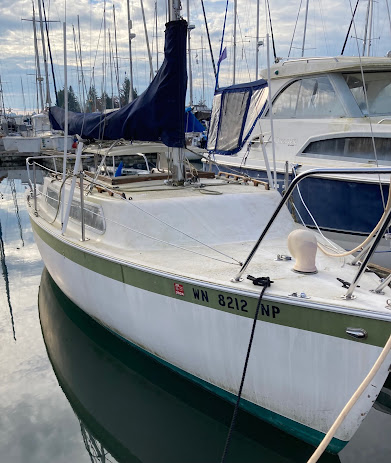The Search
Trolling through Craigslist, I spotted this ad:
The Aquarius 23 in many ways is a typical trailer sailer: lightweight, tender, with a swing keel. The unique thing about this boat is that it has a fixed six inch keel running the length of the boat containing 650 pounds of lead ballast in addition to the 165 pound swing keel; this makes her self-righting even with the keel up which is unique in the world of trailerable sailboats. When I made the long drive over, things were as expected: both boats were dirty & decrepit with lots of work to do, the owner didn’t have a title or current registration for either boat, and the trailers were in suspect condition with wheel bearings of questionable integrity. While parts of the cabin top and deck were soft, spongy and delaminated in places, the hulls seemed to be solid, though deformed where resting on the trailer’s bunks/rollers
Besides lacking title and registration, one of the boats didn’t even have a hull identification number, at least not on the upper right corner of the transom. The other boat did have a HIN, and after verifying it’s validity (see https://hindecoder.com/) I contacted the DMV to ask about registering and titling a vessel with no registration or title; turns out you can register the boat but have to wait three years to apply for a new title if you don’t have a current title certificate. Someone else came and took both boats before I could make a decision which was probably for the best.
————————
The next find was a Venture 25, a close cousin to the MacGregor 25. It’s similar in size and displacement to the Aquarius 23, but has a 600 pound swing keel that projects below the hull a bit to give some directional stability even when fully retracted. She was also in the “project boat” category with lots of work to complete; the upside: she was mostly stripped bare inside and presented a blank canvas, once all the cleanup work was completed.
It came with an ancient Johnson 2-stroke outboard that hadn’t been run in quite some time and wouldn’t start, likely due to some problem with the fuel system. The condition of the trailer (especially the wheel bearings) was suspect and the current owner refused to even consider transporting the boat for any potential buyer. I did find a service to tow it to my marina (including a ferry trip to the mainland), but the job would cost at least $900 and much more if the trailer broke down and a flatbed trailer had to be employed.
On paper, the specs looked promising and she was in decent shape for a 35+ year old boat. I took the desired measurements and it didn’t take long to figure out it wouldn’t work; she just wasn’t long enough to accommodate a hinged 18 foot mast. Even if I moved the mast forward by a couple feet (the max allowed), the mast would still extend at least 3 feet aft of the transom. The headroom in the salon would also demand a permanent slouch or stoop; intolerable for comfortable overnight cruising. Lastly, the bilge was full of water (never a good sign) and I counted at least a half dozen thru-hulls below the waterline; I consider the ideal number to be ZERO! On the plus side, I got to take a lovely walk along the harbor after the viewing and had the most delicious tuna melt and chai tea for lunch.
I took the requisite measurements and it seemed promising, despite the fact that the outboard barely started, the batteries were dead and the bilge was filled close to the top with a large slug of water. I could only find one thru-hull below the waterline, but it was in the middle of the cabin and connected to a wash-down pump. Why anyone would put a wash-down pump in the salon is beyond me! Beyond that, she was fairly well-equipped and in decent shape for her age. However, she wasn’t quite long enough for the hinged mast I had in mind and she was a bit heavy for my purposes, due to her 1200 pounds of ballast; I really prefer to lug around half that amount when using the electric motor. She would probably work, but I passed in hopes of finding something closer to ideal.
This likely means cooling problems with any sort of sea state worse than “flat calm” as the cooling inlets suck air. This just reinforces my desire to find a boat with a transom cutout allowing the engine’s lower unit to be fully submersed when tilted down and completely clear of the water by simply tilting the engine up. Also, once again, the bilge was full of water and very inaccessible (with no functioning bilge pump, yikes!). These issues can potentially be fixed, but they are not easy, or guaranteed fixes.
This boat was in the water and in better shape than the previous Aquarius 23 I looked at. I didn’t feel any spongy areas walking around the deck and the short shaft Yamaha four stroke, though old, started and ran in both forward and reverse gear. The transom cutout allows you to easily tilt the motor up out of the water, and when lowered, the prop and cooling water inlet are deeply submerged:
The interior would need to be completely gutted and redone, but I just had standing headroom in the salon when the pop top was raised. The bilge did have some water in it, so I steeled myself and took a small taste; fresh water, not salty, which means the cabin leaks (to be expected) but the hull does not. The keel bolts appeared to be in good shape. My unanswered questions: What is the weight of the keel and what’s it made of?














